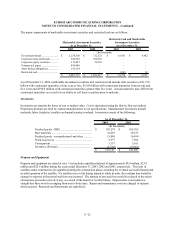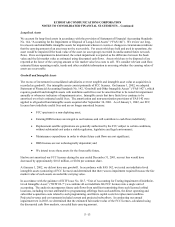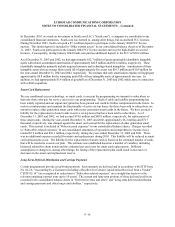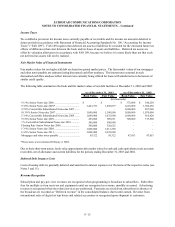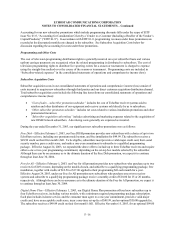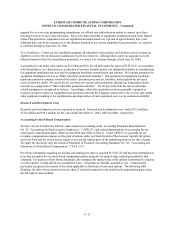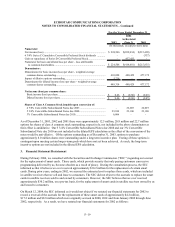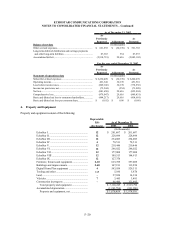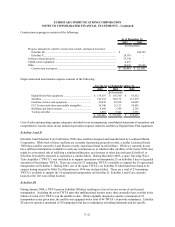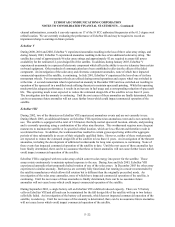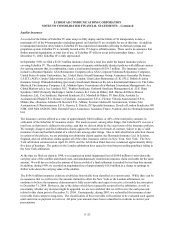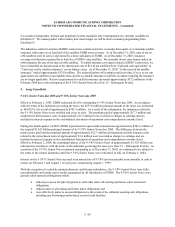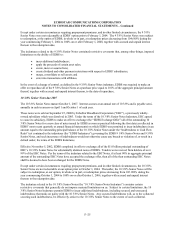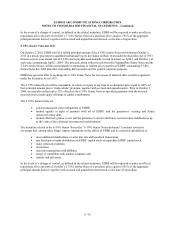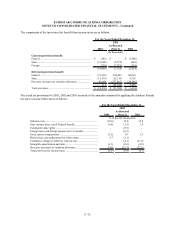Dish Network 2003 Annual Report Download - page 89
Download and view the complete annual report
Please find page 89 of the 2003 Dish Network annual report below. You can navigate through the pages in the report by either clicking on the pages listed below, or by using the keyword search tool below to find specific information within the annual report.ECHOSTAR COMMUNICATIONS CORPORATION
NOTES TO CONSOLIDATED FINANCIAL STATEMENTS – Continued
F–22
channel authorizations, currently it can only operate on 17 of the 19 FCC authorized frequencies at the 61.5 degree west
orbital location. We are currently evaluating the performance of EchoStar III and may be required to record an
impairment charge to earnings in future periods.
EchoStar V
During 2000, 2001 and 2002, EchoStar V experienced anomalies resulting in the loss of three solar array strings, and
during January 2003, EchoStar V experienced anomalies resulting in the loss of an additional solar array string. The
satellite has a total of approximately 96 solar array strings and approximately 92 are required to assure full power
availability for the estimated 12-year design life of the satellite. In addition, during January 2003, EchoStar V
experienced an anomaly in a spacecraft electronic component which affects the ability to receive telemetry from certain
on-board equipment. Other methods of communication have been established to alleviate the effects of the failed
component. An investigation of the solar array and electronic component anomalies, none of which have impacted
commercial operation of the satellite, is continuing. In July 2001, EchoStar V experienced the loss of one of its three
momentum wheels. Two momentum wheels are utilized during normal operations and a spare wheel was switched in
at the time A second momentum wheel experienced an anomaly in December 2003 and was switched out resulting in
operation of the spacecraft in a modified mode utilizing thrusters to maintain spacecraft pointing. While this operating
mode provides adequate performance, it results in an increase in fuel usage and a corresponding reduction of spacecraft
life. This operating mode is not expected to reduce the estimated design life of the satellite to less than 12 years.
The investigation into the anomaly is continuing. Until the root causes of these anomalies are finally determined, there
can be no assurance future anomalies will not cause further losses which could impact commercial operation of the
satellite.
EchoStar VIII
During 2002, two of the thrusters on EchoStar VIII experienced anomalous events and are not currently in use.
During March 2003, an additional thruster on EchoStar VIII experienced an anomalous event and is not currently in
use. The satellite is equipped with a total of 12 thrusters that help control spacecraft location, attitude, and pointing
and is currently operating using a combination of the other nine thrusters. This workaround requires more frequent
maneuvers to maintain the satellite at its specified orbital location, which are less efficient and therefore result in
accelerated fuel use. In addition, the workaround has resulted in certain gyroscopes being utilized for aggregate
periods of time substantially in excess of their originally qualified limits. However, neither of these workarounds
are expected to reduce the estimated design life of the satellite to less than 12 years. An investigation of the thruster
anomalies, including the development of additional workarounds for long term operations, is continuing. None of
these events has impacted commercial operation of the satellite to date. Until the root cause of these anomalies has
been finally determined, there can be no assurance that these or future anomalies will not cause further losses which
could impact commercial operation of the satellite.
EchoStar VIII is equipped with two solar arrays which convert solar energy into power for the satellite. Those
arrays rotate continuously to maintain optimal exposure to the sun. During June and July 2003, EchoStar VIII
experienced anomalies that temporarily halted rotation of one of the solar arrays. In December 2003 the other array
experienced a similar anomaly. Both arrays are currently fully functional, but rotating in a mode recommended by
the satellite manufacturer which allows full rotation but is different than the originally prescribed mode. An
investigation of the solar array anomalies, none of which have impacted commercial operation of the satellite, is
continuing. Until the root cause of these anomalies is finally determined, there can be no assurance future
anomalies will not cause losses which could impact commercial operation of the satellite.
During September 2003, a single battery cell on EchoStar VIII exhibited reduced capacity. There are 72 battery
cells on EchoStar VIII and all loads can be maintained for the full design life of the satellite with up to two battery
cells fully failed. An investigation of the battery cell anomaly, which has not impacted commercial operation of the
satellite, is underway. Until the root cause of the anomaly is determined, there can be no assurance future anomalies
will not cause losses which could impact commercial operation of the satellite.


